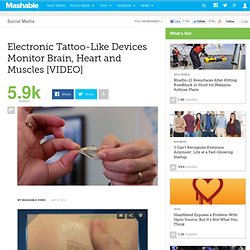

New T-ray Medical Scanners Look Like Ones on Star Trek. New nano-antenna technology means doctors are on their way to having the medical tools used aboard Star Trek's fictional USS Enterprise.

Star Trek's Dr. Leonard McCoy was the renowned chief medical officer of the Starship Enterprise. The only thing McCoy is better known for other than his "I'm a doctor, not a... " catchphrases, is his use of the most technological advanced medical tools such as the Tricordor scanner. Researchers from the Institute of Materials Research and Engineering and Imperial College London are close to developing a medical scanner similar to McCoy's Tricorder. The breakthrough involves developing new nano-antennas that make electromagnetic Teraherts (Thz) waves 100 times stronger than current THz scanners on the market are capable of, according to researchers. SEE ALSO: 8 Star Trek Gadgets That Are No Longer Fiction T-ray imaging devices are currently expensive and operate on a low output power.
T-rays can be used to detect explosives, drugs and gas pollution. Electronic Tattoo-Like Devices Monitor Brain, Heart and Muscles. We might one day be able to monitor our bodies' internal functions — and prevent things like epileptic seizures before they happen — using a flexible circuit attached to the surface of skin.

The National Science Foundation announced Monday that researchers are working on a prototype tattoo-like device that can detect heart, muscle and brain activity. Tiny curly wires in a flexible membrane make up these devices and work better than conventional hard, brittle circuits, because body tissue itself is soft and pliable. "We're trying to bridge that gap, from silicon, wafer-based electronics to biological, 'tissue-like' electronics, to really blur the distinction between electronics and the body," said materials scientist John Rogers from the University of Illinois Urbana-Champaign. "As the skin moves and deforms, the circuit can follow those deformations in a completely noninvasive way. " Nanotechnology Puts a Medical Lab in Your Hand. All the frills in life are shrinking in size.
Laptops, cellphones and even big-screen televisions have been getting thinner and thinner. So why shouldn’t necessary technology like medical labs and scientific tools get the same slimming treatment? Now they are: advances in nanotechnology have made it possible to put an entire medical lab into one high-powered chip, which not only fits in the palm of your hand, but also performs diagnostic tests in a matter of minutes.
Researchers are gradually finding ways to create reliable, nano-sized labs that are able to perform a variety of diagnostic tests, which used to require teams of people and weeks of waiting. The tiny wafers of glass or plastic work by compressing a series of tests. In Duke’s chip, a drop of blood is separated by nanometer-sized pillars, which then trap larger elements such as blood cells and proteins. This is just one application for the lab-on-a-chip. National electronic health records network gets closer - Nov. 18. An electronic health records network is becoming a reality, as the national attitude towards health IT is shifting towards acceptance.

NEW YORK (CNNMoney) -- The ambitious goal of setting up a nationwide, interconnected, private and secure electronic health records system isn't yet a reality -- but we're getting closer. The 2009 Recovery Act, better known as the stimulus bill, set aside more than $20 billion for incentives to health care providers that deploy and meaningfully use certified electronic health records systems in their offices or hospitals. The first incentives are set to go out in the form of $22,000 Medicaid payments to early adopters within the next six months. Since we're still in the early phases, it's hard to get clear numbers for adoption rates. Prior to the bill, just 17% of physicians' offices and 12% of hospitals had implemented some kind of electronic health records system.
The government's solution is to make processes digital and connected.